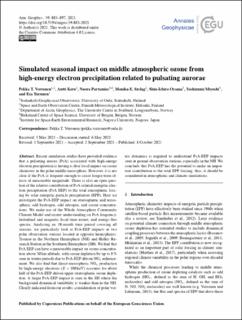| dc.contributor.author | Verronen, Pekka T. | |
| dc.contributor.author | Kero, Antti | |
| dc.contributor.author | Partamies, Noora | |
| dc.contributor.author | Szelag, Monika E. | |
| dc.contributor.author | Oyama, Shin-Ichiro | |
| dc.contributor.author | Miyoshi, Yoshizumi | |
| dc.contributor.author | Turunen, Esa | |
| dc.date.accessioned | 2022-02-17T08:50:51Z | |
| dc.date.available | 2022-02-17T08:50:51Z | |
| dc.date.created | 2021-10-22T18:50:31Z | |
| dc.date.issued | 2021 | |
| dc.identifier.issn | 0992-7689 | |
| dc.identifier.uri | https://hdl.handle.net/11250/2979557 | |
| dc.description.abstract | Recent simulation studies have provided evidence that a pulsating aurora (PsA) associated with high-energy electron precipitation is having a clear local impact on ozone chemistry in the polar middle mesosphere. However, it is not clear if the PsA is frequent enough to cause longer-term effects of measurable magnitude. There is also an open question of the relative contribution of PsA-related energetic electron precipitation (PsA EEP) to the total atmospheric forcing by solar energetic particle precipitation (EPP). Here we investigate the PsA-EEP impact on stratospheric and mesospheric odd hydrogen, odd nitrogen, and ozone concentrations. We make use of the Whole Atmosphere Community Climate Model and recent understanding on PsA frequency, latitudinal and magnetic local time extent, and energy-flux spectra. Analysing an 18-month time period covering all seasons, we particularly look at PsA-EEP impacts at two polar observation stations located at opposite hemispheres: Tromsø in the Northern Hemisphere (NH) and Halley Research Station in the Southern Hemisphere (SH). We find that PsA EEP can have a measurable impact on ozone concentration above 30 km altitude, with ozone depletion by up to 8 % seen in winter periods due to PsA-EEP-driven NOx enhancement. We also find that direct mesospheric NOx production by high-energy electrons (E> 100 keV) accounts for about half of the PsA-EEP-driven upper stratospheric ozone depletion. A larger PsA-EEP impact is seen in the SH where the background dynamical variability is weaker than in the NH. Clearly indicated from our results, consideration of polar vortex dynamics is required to understand PsA-EEP impacts seen at ground observation stations, especially in the NH. We conclude that PsA-EEP has the potential to make an important contribution to the total EPP forcing; thus, it should be considered in atmospheric and climate simulations. | en_US |
| dc.language.iso | eng | en_US |
| dc.publisher | Copernicus Publications | en_US |
| dc.rights | Navngivelse 4.0 Internasjonal | * |
| dc.rights.uri | http://creativecommons.org/licenses/by/4.0/deed.no | * |
| dc.title | Simulated seasonal impact on middle atmospheric ozone from high-energy electron precipitation related to pulsating aurorae | en_US |
| dc.type | Journal article | en_US |
| dc.type | Peer reviewed | en_US |
| dc.description.version | publishedVersion | en_US |
| dc.rights.holder | Copyright Author(s) 2021 | en_US |
| cristin.ispublished | true | |
| cristin.fulltext | original | |
| cristin.qualitycode | 1 | |
| dc.identifier.doi | 10.5194/angeo-39-883-2021 | |
| dc.identifier.cristin | 1947909 | |
| dc.source.journal | Annales Geophysicae | en_US |
| dc.source.pagenumber | 883-897 | en_US |
| dc.identifier.citation | Annales Geophysicae. 2021, 39 (5), 883-897. | en_US |
| dc.source.volume | 39 | en_US |
| dc.source.issue | 5 | en_US |

